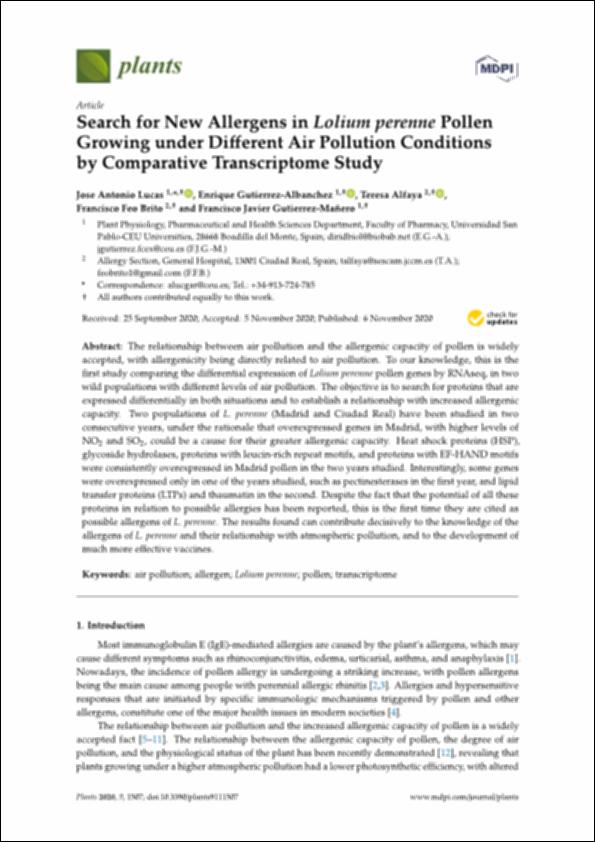Por favor, use este identificador para citar o enlazar este ítem:
http://hdl.handle.net/10637/15906Search for New Allergens in Lolium perenne Pollen Growing under Different Air Pollution Conditions by Comparative Transcriptome Study
| Título : | Search for New Allergens in Lolium perenne Pollen Growing under Different Air Pollution Conditions by Comparative Transcriptome Study |
| Autor : | Lucas García, José Antonio Gutierrez-Albanchez, Enrique Alfaya Arias, Teresa Feo Brito, Francisco Gutiérrez Mañero, Francisco Javier |
| Materias: | Aire -- Contaminación; Alergenos; Polen |
| Editorial : | MDPI |
| Citación : | Lucas, Jose Antonio, Enrique Gutierrez-Albanchez, Teresa Alfaya, Francisco Feo Brito, and Francisco Javier Gutierrez-Mañero. 2020. "Search for New Allergens in Lolium perenne Pollen Growing under Different Air Pollution Conditions by Comparative Transcriptome Study" Plants 9, no. 11: 1507. https://doi.org/10.3390/plants9111507 |
| Resumen : | The relationship between air pollution and the allergenic capacity of pollen is widely accepted, with allergenicity being directly related to air pollution. To our knowledge, this is the first study comparing the differential expression of Lolium perenne pollen genes by RNAseq, in two wild populations with different levels of air pollution. The objective is to search for proteins that are expressed differentially in both situations and to establish a relationship with increased allergenic capacity. Two populations of L. perenne (Madrid and Ciudad Real) have been studied in two consecutive years, under the rationale that overexpressed genes in Madrid, with higher levels of NO2 and SO2, could be a cause for their greater allergenic capacity. Heat shock proteins (HSP), glycoside hydrolases, proteins with leucin-rich repeat motifs, and proteins with EF-HAND motifs were consistently overexpressed in Madrid pollen in the two years studied. Interestingly, some genes were overexpressed only in one of the years studied, such as pectinesterases in the first year, and lipid transfer proteins (LTPs) and thaumatin in the second. Despite the fact that the potential of all these proteins in relation to possible allergies has been reported, this is the first time they are cited as possible allergens of L. perenne. The results found can contribute decisively to the knowledge of the allergens of L. perenne and their relationship with atmospheric pollution, and to the development of much more effective vaccines |
| Descripción : | Material complementario en: https://www.mdpi.com/2223-7747/9/11/1507/s1 |
| URI : | http://hdl.handle.net/10637/15906 |
| Derechos: | http://creativecommons.org/licenses/by-nc-nd/4.0/deed.es Open Access |
| ISSN : | 2223-7747 |
| Fecha de publicación : | 6-nov-2020 |
| Centro : | Universidad San Pablo-CEU |
| Aparece en las colecciones: | Facultad de Farmacia |
Los ítems de DSpace están protegidos por copyright, con todos los derechos reservados, a menos que se indique lo contrario.


